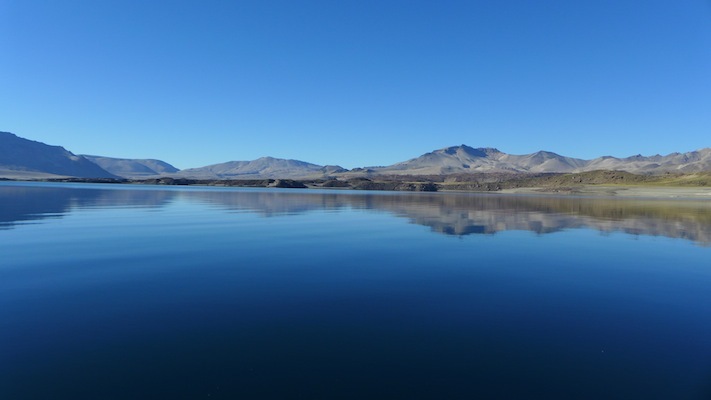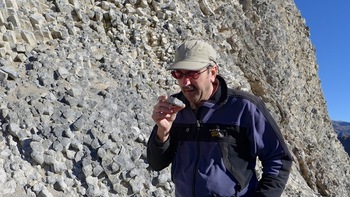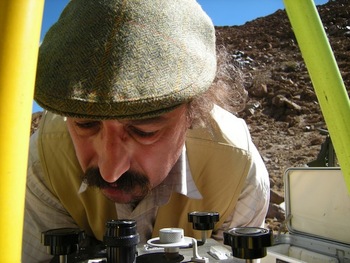UW team explores large, restless volcanic field in Chile

Laguna del Maule, Chile, is at the center of a volcanic field that has erupted 36 times during the last 25,000 years, and is now experiencing significant uplift due to magma intrusion.
Photos: David Tenenbaum
If Brad Singer knew for sure what was happening three miles under an odd-shaped lake in the Andes, he might be less eager to spend a good part of his career investigating a volcanic field that has erupted 36 times during the last 25,000 years. As he leads a large scientific team exploring a region in the Andes called Laguna del Maule, Singer hopes the area remains quiet.
But the primary reason to expend so much effort on this area boils down to one fact: The rate of uplift is among the highest ever observed by satellite measurement for a volcano that is not actively erupting.
That uplift is almost definitely due to a large intrusion of magma — molten rock — beneath the volcanic complex. For seven years, an area larger than the city of Madison has been rising by 10 inches per year.
That rapid rise provides a major scientific opportunity: to explore a mega-volcano before it erupts. That effort, and the hazard posed by the restless magma reservoir beneath Laguna del Maule, are described in a major research article in the December issue of the Geological Society of America’s GSA Today.

Brad Singer inspects a densely-fractured lava flow that cooled rapidly against ice.
“We’ve always been looking at these mega-eruptions in the rear-view mirror,” says Singer. “We look at the lava, dust and ash, and try to understand what happened before the eruption. Since these huge eruptions are rare, that’s usually our only option. But we look at the steady uplift at Laguna del Maule, which has a history of regular eruptions, combined with changes in gravity, electrical conductivity and swarms of earthquakes, and we suspect that conditions necessary to trigger another eruption are gathering force.”
Laguna del Maule looks nothing like a classic, cone-shaped volcano, since the high-intensity erosion caused by heavy rain and snow has carried most of the evidence to the nearby Pacific Ocean. But the overpowering reason for the absence of “typical volcano cones” is the nature of the molten rock underground. It’s called rhyolite, and it’s the most explosive type of magma on the planet.
The eruption of a rhyolite volcano is too quick and violent to build up a cone. Instead, this viscous, water-rich magma often explodes into vast quantities of ash that can form deposits hundreds of yards deep, followed by a slower flow of glassy magma that can be tens of yards tall and measure more than a mile in length.
“We know that over the past million years or so, several eruptions at Laguna del Maule or nearby volcanoes have been more than 100 times larger than Mount St. Helens.”
Brad Singer
The next eruption could be in the size range of Mount St. Helens — or it could be vastly bigger, Singer says. “We know that over the past million years or so, several eruptions at Laguna del Maule or nearby volcanoes have been more than 100 times larger than Mount St. Helens,” he says. “Those are rare, but they are possible.” Such a mega-eruption could change the weather, disrupt the ecosystem and damage the economy.
Trying to anticipate what Laguna del Maule holds in store, Singer is heading a new $3 million, five-year effort sponsored by the National Science Foundation to document its behavior before an eruption. With colleagues from Chile, Argentina, Canada, Singapore, and Cornell and Georgia Tech universities, he is masterminding an effort to build a scientific model of the underground forces that could lead to eruption. “This model should capture how this system has evolved in the crust at all scales, from the microscopic to basinwide, over the last 100,000 years,” Singer says. “It’s like a movie from the past to the present and into the future.”
Over the next five years, Singer says he and 30 colleagues will “throw everything, including the kitchen sink, at the problem — geology, geochemistry, geochronology and geophysics — to help measure, and then model, what’s going on.”
One key source of information on volcanoes is seismic waves. Ground shaking triggered by the movement of magma can signal an impending eruption. Team member Clifford Thurber, a seismologist and professor of geoscience at UW–Madison, wants to use distant earthquakes to locate the underground magma body.

Team member Basil Tikoff measures changes in gravity that likely result from rising bodies of hot rock.
As many as 50 seismometers will eventually be emplaced above and around the magma at Laguna del Maule, in the effort to create a 3-D image of Earth’s crust in the area.
By tracking multiple earthquakes over several years, Thurber and his colleagues want to pinpoint the size and location of the magma body — roughly estimated as an oval measuring five kilometers (3.1 miles) by 10 kilometers (6.2 miles).
Each seismometer will record the travel time of earthquake waves originating within a few thousand kilometers, Thurber explains. Since soft rock transmits sound less efficiently than hard rock, “we expect that waves that pass through the presumed magma body will be delayed,” Thurber says. “It’s very simple. It’s like a CT scan, except instead of density we are looking at seismic wave velocity.”
As Singer, who has been visiting Laguna del Maule since 1998, notes, “The rate of uplift — among the highest ever observed — has been sustained for seven years, and we have discovered a large, fluid-rich zone in the crust under the lake using electrical resistivity methods. Thus, there are not many possible explanations other than a big, active body of magma at a shallow depth.”
The expanding body of magma could freeze in place — or blow its top, he says. “One thing we know for sure is that the surface cannot continue rising indefinitely.”




